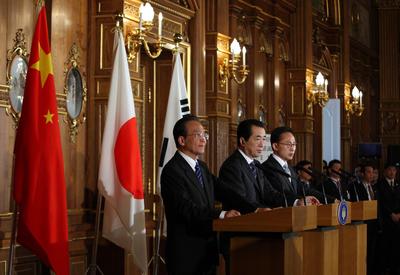To this end, the three countries have agreed to cooperate on disaster management and nuclear safety, accelerate talks for a Trilateral Investment Agreement and Free Trade Agreement to aid Japan’s economic growth, and attempt to expand the numbers of Chinese and South Korean tourists travelling to Japan.
The trilateral summit has also taken on wider significance for the China-Japan bilateral relationship. The summit — as well as China’s efforts at ‘disaster diplomacy’ in the two months since Japan’s earthquake — has provided a critical opportunity for China and Japan to get bilateral ties back on track after the Senkaku/Diaoyu islands incident in September 2010. And duly, some bilateral cooperation was delivered during the summit. For example, in meetings with Japan, Chinese Premier Wen Jiabao agreed to partially relax import control measures on food products from two of the radiation-affected prefectures in Japan. The two countries also discussed efforts to boost tourism and economic cooperation.
The practical agreements made by Japanese Prime Minister Naoto Kan and Wen Jiabao in the wake of the disasters should help to put the China-Japan relationship back on track. But what does ‘back on track’ mean in the context of the larger China-Japan relationship? The 21–22 May meetings certainly achieved some success in revitalising relations after the low point of the Senkaku/Diaoyu islands dispute; and as Aurelia George Mulgan notes, we should not underestimate the significance of that low-point, not only in diplomatic terms, but in military and economic terms as well. But is September 2010 a fair point of comparison to gauge whether the China-Japan relationship is now ‘back on track’? Less than a year before the Senkaku/Diaoyu islands incident, it seemed that China-Japan relations were improving after the Democratic Party of Japan came to power, and hundreds of Japanese Diet-members and business leaders visited China.
This points to the regularity of ups and downs in the Sino-Japanese relationship over the long-term, which makes it difficult to assess the significance of a one-off event. Scholars have rightly questioned whether China’s ‘disaster diplomacy’ or the trilateral summit will have any long-term impact on China-Japan relations. On the one hand, there is a positive story to tell if we focus on sympathy and aid from the Chinese in the wake of the earthquake. On the other hand, it is just as easy to highlight more negative developments. For instance, China and Japan have made almost no progress on two of the more difficult issues they currently face: the export of rare earths to Japan and contested claims over the Senkaku/Diaoyu islands.
Rather than weighing up the positives against the negatives, it is more instructive to analyse broad trends in the bilateral relationship over the long-term. In this respect, there is a particular continuity in the relationship worth examining: trade.
Shiro Armstrong has demonstrated that Sino-Japanese economic ties have withstood the political turbulence in the relationship over the last 30 years. In 2009, China became Japan’s largest trade partner, and Japan is China’s second-most important trade partner after the US. Wen Jiabao noted that in 2010, Japan-China trade was close to US$300 billion, and Japan was one of China’s major sources of foreign capital. The booming Sino-Japanese economic relationship of today originated out of a set of small, unofficial trade agreements negotiated by Chinese and Japanese individuals throughout the 1950s and 1960s. In that divided Cold War era, the two sides relied on economic diplomacy to build a relationship where official diplomacy could not.
What is especially significant is that economic ties between the two countries predate the normalisation of diplomatic relations in 1972. My own research argues that a more significant date from the perspective of bilateral trade would be 1962, when the Liao-Takasaki trade agreement was signed between representatives of the two countries. This trade agreement paved the way for Japan to replace the Soviet Union as China’s most important trade partner in 1965.
Despite all this, former Editor in Chief of the Asahi Shimbun, Yoichi Funabashi, has recently argued that now is the time for Japan to ‘break with the past and move closer to China.’ But would moving closer really be a break with the past? There are doubtless new opportunities for Japanese firms to shift their operations to China following the earthquake, and the proposed Japan-China-ROK FTA could certainly reduce trade barriers between Japan and China. But Funabashi’s editorial significantly underplays the existing size and longevity of the economic relationship. It is all too easy to write off the Japan-China relationship as one plagued by historical animosity. But we should not ignore the vast economic ties that have long held these two states together.
Amy King is a doctoral student researching Sino-Japanese relations at Oxford University.


The China-Japan relationship is one of the most difficult on earth which neither the Chinese nor the Japanese will deny. Both the Chinese and Japanese are very very very strong willed people and have proven their resolve to triumph over all sorts of adversities including those where they are compelled to make grave sacrifices. Such difficult people, if they are able to click will be very very very difficult to separate. The wild volatility of their relationship reflects that both are patiently nurturing their wilder sides to harmonize their relationship. Time will tell.